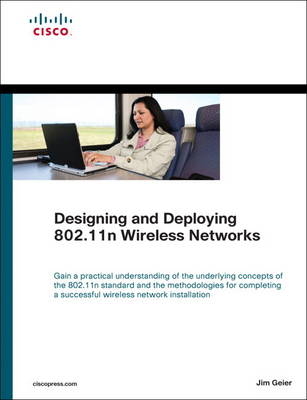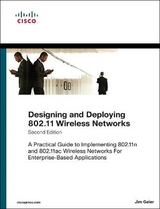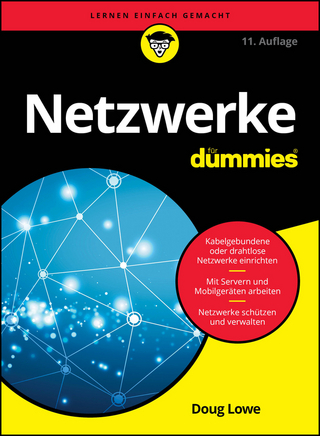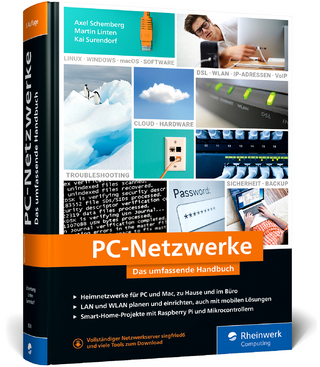
Designing and Deploying 802.11n Wireless Networks
Cisco Press (Verlag)
978-1-58705-889-9 (ISBN)
- Titel erscheint in neuer Auflage
- Artikel merken
Gain a practical understanding of the underlying concepts of the 802.11n standard and the methodologies for completing a successful wireless network installation
Practical, start-to-finish guidance for successful deployment of 802.11n wireless LANs
With the ratification of the 802.11n wireless LAN standard, thousands of companies are moving rapidly toward implementation. However, 802.11n is very different from legacy 802.11a, 802.11b, and 802.11g wireless standards, and successful deployment requires new knowledge and techniques. In this book, leading wireless expert Jim Geier systematically presents all the information and guidance that network architects, engineers, administrators, and managers need to maximize the performance and business value of new 802.11n networks.
Drawing on extensive experience with real-world 802.11n deployments, Geier guides you through the entire project lifecycle: planning, design, installation, testing, monitoring, and support. Each phase of wireless LAN deployment is organized into clearly defined steps, and multiple case studies and hands-on exercises show how to apply each technique.
You’ll find practical guidance for deploying in enterprises without existing wireless infrastructure, as well as migrating from legacy 802.11a, 802.11b, or 802.11g networks. For convenient reference, Geier also provides an extensive, up-to-date wireless networking glossary.
Jim Geier founded Wireless-Nets, Ltd., and serves as its principal consultant. His 25 years of experience include analysis, design, implementation, installation, and support of wireless network-based solutions for cities, enterprises, airports, manufacturers, warehouses, hospitals, and other facilities worldwide. He is author of more than a dozen books, including Wireless Networks - First Step and Deploying Voice over Wireless LANs (Cisco Press) and Implementing 802.1X Security Solutions. He has been active with the IEEE 802.11 Working Group developing international wireless LAN standards, and chaired the IEEE International Conference on Wireless LAN Implementation.
Understanding 802.11n MAC, physical layer, and related standards
Designing 802.11n wireless networks for diverse scenarios: considering architecture, range, performance, roaming, and RF issues
Migrating from 802.11a, 802.11b, and 802.11g wireless networks
Choosing the right tools and equipment, and using them effectively
Planning effectively: scoping projects; creating work breakdown structures; organizing teams, schedules, and budgets; defining requirements, and more
Securing WLANs via encryption, authentication, rogue access point detection, RF shielding, and polices
Performing site surveys and identifying optimum access point locations
Installing and configuring wireless LANs: planning, staging, deployment, documentation, and more
Systematic testing to improve signal coverage, performance, and security
Managing wireless LANs: help desk support, network monitoring, maintenance, engineering, configuration management, security, tools, and more
Troubleshooting 802.11n networks: identifying issues with connectivity, performance, and more
Jim Geier is the founder and principal consultant of Wireless-Nets, Ltd., an independent consulting firm assisting organizations with the development and deployment of wireless networks. His 25 years of experience includes the planning, analysis, design, implementation, installation, and support of numerous wireless network-based solutions for enterprises, municipalities, hospitals, universities, airports, warehouses, and product manufacturers worldwide. Jim is the author of more than a dozen books, including Deploying Voice over Wireless LANs (Cisco Press), Wireless Networks: First Step (Cisco Press), Implementing 802.1X Security Solutions (Wiley), and Network Reengineering (McGraw-Hill). He is the author of numerous tutorials and other publications and has developed and instructed dozens of training courses on wireless networking topics. Jim has been active within the Wi-Fi Alliance, responsible for certifying interoperability of 802.11 (Wi-Fi) wireless LANs. He has also been active with the IEEE 802.11 Working Group, responsible for developing international standards for wireless LANs. He served as Chairman of the IEEE Computer Society, Dayton Section, and Chairman of the IEEE International Conference on Wireless LAN Implementation. Jim’s education includes a Bachelor’s and Master’s degree in electrical engineering, with emphasis in wireless communications.
Introduction xxv
Part I Fundamental Concepts
Chapter 1 Introduction to Wireless LANs 1
Wireless LAN Markets and Applications 1
Retail 2
Warehousing 3
Healthcare 4
Hospitality 9
Voice over WLAN 9
Video Surveillance 11
Home and Small Office 12
General Enterprise Systems 13
Location-Aware Wireless Applications 13
Benefits of Wireless Networks 15
Mobility 15
Installation in Difficult-to-Wire Areas 16
Increased Reliability 17
Reduced Installation Time 17
Long-Term Cost Savings 17
Productivity Gain Is the Answer 18
Wireless Network Technologies 19
IEEE 802.11 (Wi-Fi) 20
Initial 802.11 20
802.11a 21
802.11b 21
802.11g 22
802.11n 23
Comparison of 802.11 Standards 24
Wi-Fi Certification 24
Other Wireless Network Technologies 26
IEEE 802.16 (WiMAX) 26
IEEE 802.15 (Bluetooth) 30
IEEE 802.15.4 (ZigBee) 32
Certified Wireless USB 33
Wireless LANs: A Historical Perspective 34
The Early Days 34
Initial 802.11 Standardization 35
802.11n Standardization 36
Chapter 2 Radio Wave Fundamentals 39
Radio Wave Attributes 39
Amplitude 40
Frequency 40
Phase 41
RF System Components 41
RF Transceiver 41
RF Modulation 43
Amplitude Shift-Keying 43
Frequency Shift-Keying 44
Phase Shift-Keying 45
Quadrature Amplitude Modulation 45
Spread Spectrum 45
Orthogonal Frequency-Division Multiplexing 48
RF Signal Propagation 48
Attenuation 48
Free Space Loss 49
Physical Obstacles 50
Multipath Propagation 51
Noise and Signal-to-Noise Ratio 51
RF Mathematics 53
Converting Units 53
Chapter 3 Wireless LAN Types and Components 55
Types of Wireless LANs 55
Ad Hoc Wireless LANs 55
Infrastructure Wireless LANs 57
Mesh Wireless Networks 59
Wireless LAN Components 62
Client Devices 62
Client Radio 63
Industry Standard Architecture 65
Peripheral Component Interconnect 66
Mini-PCI 66
PC Card 66
ExpressCard 67
CompactFlash 67
Universal Serial Bus 67
Access Points 68
Autonomous Access Points 68
Controller-Based Access Points 69
Wi-Fi Routers 69
Mesh Nodes 72
Antennas 72
RF Amplifiers 74
Repeaters 75
Bridges 75
Network Infrastructure Components 77
Network Distribution Systems 77
Switches 77
Optical Fiber 79
Power over Ethernet 79
Application Connectivity Software 82
Terminal Emulation 82
Browser-Based Approaches 83
Direct Database Interfaces 84
Wireless Middleware 84
Chapter 4 Wireless LAN Implications 87
Security Vulnerabilities 87
Passive Monitoring 88
Unauthorized Access 91
Denial of Service 95
Radio Signal Interference 97
Microwave Oven Interference 99
Cordless Phone Interference 101
Bluetooth Interference 103
Neighboring Wireless LAN Interference 105
Impacts of Multipath Propagation 108
Roaming Issues 109
Battery Limitations 110
Interoperability Problems 111
Installation Issues 112
Part II The 802.11 Standard
Chapter 5 Introduction to IEEE 802.11 and Related Standards 115
The Importance of Standards 115
Types of Standards 115
Institute for Electrical and Electronic Engineers 117
Benefits of the 802.11 Standard 117
Appliance Interoperability 118
Fast Product Development 119
Stable Future Migration 119
Price Reductions 119
Avoiding Silos 119
The IEEE 802 LAN Standards Family 120
802.11 MAC Sublayer 121
802.11 Physical Layer 123
IEEE 802.2 123
Unacknowledged Connectionless Service 124
Connection-Oriented Service 125
Continuous ARQ 126
Stop-and-Wait ARQ 127
Acknowledged Connectionless Service 128
IEEE 802.11 Features 129
Station Services 130
Authentication 130
Deauthentication 131
Privacy 131
Distribution System Services 131
Association 131
Disassociation 131
Distribution 131
Integration 132
Reassociation 132
Station States and Corresponding Frame Types 132
Chapter 6 IEEE 802.11 Medium Access Control (MAC) Layer 135
Primary 802.11 MAC Layer Functions 135
Data Delivery 136
Medium Access 137
Distributed Coordination Function 138
Hybrid Coordination Function 139
Error Recovery 140
Data Frame Acknowledgments 140
Dynamic Rate Switching 141
Data Frame Aggregation 142
MSDU Aggregation 143
MPDU Aggregation 143
Data Frame Fragmentation 143
Encryption 145
Wired Equivalent Privacy 145
Temporal Key Integrity Protocol 146
Advanced Encryption Standard 146
Multicasting 147
Connectivity 148
Scanning for Networks 149
Authentication 151
Open System Authentication 151
Shared Key Authentication 152
IEEE 802.1X Port-Based Authentication 153
Association 154
Reassociation 155
Timing and Synchronization 156
Short IFS 156
PCF IFS 157
DCF IFS 157
Extended IFS 157
RTS/CTS 158
Power Management 159
802.11 MAC Frame Structures 160
Protocol Version Field 160
Type Field 161
Subtype Field 161
To DS Field 161
From DS Field 161
More Frag Field 161
Retry Field 163
Power Management Field 163
More Data Field 164
Protected Frame Field 164
Order Field 164
Duration/ID Field 164
Address 1, 2, 3, and 4 Fields 164
Sequence Control Field 165
QoS Control Field 166
HT Control Field 166
Frame Body Field 166
Frame Check Sequence Field 166
MAC Frame Types 166
Management Frames 167
Association Request Frame 167
Association Response Frame 167
Reassociation Request Frame 167
Reassociation Response Frame 167
Probe Request Frame 168
Probe Response Frame 168
Beacon Frame 168
ATIM Frame 170
Disassociation Frame 170
Authentication Frame 170
Deauthentication Frame 170
Action Frame 170
Action No ACK Frame 171
Management Frame Body Contents 171
Control Frames 172
Control Wrapper Frame 172
Block ACK Request Frame 172
Block ACK Frame 172
Power-Save Poll Frame 173
Request-to-Send Frame 173
Clear-to-Send Frame 173
Acknowledgment Frame 173
Contention-Free End Frame 173
CF End + CF ACK Frame 173
Data Frames 174
Interoperability 174
Chapter 7 IEEE 802.11 Physical Layers 177
802.11 Physical Layer Architecture 177
PLCP Sublayer 177
PMD Sublayer 178
802.11 Physical Layer Functions 179
Carrier-Sense Function 179
Transmit Function 179
Receive Function 180
Legacy 802.11 Physical Layers 180
Frequency-Hopping Spread-Spectrum PHY 180
Direct-Sequence Spread-Spectrum PHY 182
Infrared PHY 185
Orthogonal Frequency Division Multiplexing PHY (802.11a) 185
High-Rate Direct-Sequence Spread-Spectrum PHY (802.11b) 188
Extended-Rate PHY (802.11g) 190
HT-OFDM (802.11n) 190
MIMO Concepts 190
Transmit Beamforming 190
Spatial Multiplexing 191
Channel Bonding 193
802.11n Modulation 194
Interoperability 198
Part III Wireless Network Design
Chapter 8 Planning a Wireless LAN Deployment 201
Project Management Principles 202
Wireless LAN Deployment Planning Steps 204
Step 1: Defining the Project Scope 204
Project Charter 204
Assumptions 204
Constraints 205
Step 2: Developing the Work Breakdown Structure 206
Requirements Definition Phase 206
Design Phase 207
Implementation Phase 209
Operations and Maintenance Phase 211
Step 3: Identifying Staffing 214
Step 4: Creating a Schedule 217
Step 5: Developing a Budget 218
Preliminary Requirements and Design 218
Hardware and Software Costs 219
Deployment Services Costs 221
Ongoing Operations and Maintenance Costs 223
Step 6: Evaluating Risks 225
Step 7: Analyzing Feasibility 227
Costs 228
Benefits 228
Impacts on Users 229
Impacts on Existing Systems 229
Making the Decision to Proceed 229
Executing the Project 232
The Kick-Off Meeting 232
Periodic Activities 233
Evaluating the Outcome of the Project 233
Chapter 9 Defining Requirements for a Wireless LAN 237
Requirements Attributes 238
Requirements Definition Steps 238
Step 1: Gathering Information 239
Interviewing Users 239
Interviewing IT Staff 240
Reviewing the Existing Infrastructure and Systems 240
Step 2: Analyzing Requirements 241
Application Requirements 241
Client Device Requirements 243
Signal Coverage Requirements 244
Utilization Requirements 246
Mobility Requirements 248
Continuous Movement 248
Portable Access 249
Stationary Access 249
Security Requirements 250
Sensitivity of Information and Systems 250
Organization Security Policies 251
Network Access Privileges 251
Existing Security Mechanisms 252
Scalability Requirements 253
Existing Network Infrastructure Requirements 254
Integration Requirements 255
Environmental Requirements 256
Building Construction and Obstacles 256
Floor Plans 256
Temperature and Humidity 256
Durability 257
Aesthetic Requirements 258
Step 3: Documenting Requirements 259
Step 4: Obtaining Requirements Approval 260
Chapter 10 System Architecture Considerations 263
Architectural Considerations 264
Wireless Access Networks 264
Autonomous Access Point Architecture 265
Controller-Based Access Point Architecture 267
Mesh Network Architecture 269
Ad Hoc Architecture 270
2.4 GHz Versus 5 GHz 272
Geographical Location Considerations 272
Performance Considerations 272
Existing Client Device Considerations 273
Facility Size Considerations 273
Radio Signal Interference Considerations 273
Hybrid Frequency Band Considerations 274
Common Infrastructure Considerations 274
Migration Considerations 276
Redundancy Considerations 277
Controller Redundancy 277
Access Point Redundancy 279
Distribution Systems 282
Switch Considerations 282
PoE Considerations 282
Voice over WLAN Systems 284
Single-Site Architecture 284
Multisite WAN with Centralized Call Processing 285
Multisite WAN with Distributed Call Processing 287
Application Connectivity 289
Terminal Emulation Considerations 289
Browser-Based Connectivity Considerations 292
Direct Database Considerations 293
Wireless Middleware Considerations 294
Chapter 11 Range, Performance, and Roaming Considerations 299
Range Versus Performance 299
Range Considerations 300
Signal Coverage Requirements 300
Radio Frequency Bands 301
Transmit Power Settings 302
Transmission Channel Settings 303
Data Rate Settings 304
Antennas 306
Amplifiers 307
Repeaters 308
Physical Obstacles 309
Radio Signal Interference 309
Performance Considerations 311
Throughput Versus Data Rate 312
Radio Frequency Bands 313
Transmit Power Settings 313
Transmission Channel Settings 314
Data Rate Settings 315
Antennas 315
Amplifiers 316
Radio Signal Interference 316
Channel Width Settings 316
Signal Coverage 317
Fragmentation Settings 317
RTS/CTS Settings 318
Bandwidth Control Mechanisms 319
Microcell Deployment Strategies 319
Roaming Considerations 321
Roaming Levels 322
Access Point Roaming 322
Subnet Roaming 323
Wireless ISP Roaming 324
Wireless IP Phone Roaming 324
Mobility Settings 325
Chapter 12 Radio Frequency Considerations 327
Frequency Band Selection 327
2.4-GHz Frequency Band 327
5-GHz Frequency Band 328
Transmission Channel Settings 328
Manual Channel Settings 328
Single-Level Facilities 329
Multilevel Facilities 330
Adaptive Channel Settings 332
Difficult-to-Cover Areas 333
Signal Coverage in Elevators 333
Signal Coverage in Stairwells 336
Signal Coverage in Parking Areas 336
Radio Signal Interference Reduction 337
Chapter 13 Security Considerations 339
Security Elements 339
Encryption 340
Authentication 342
EAP Methods 342
Authentication Servers 344
Guest Access 345
Rogue Access Point Detection 346
RF Shielding 347
Wireless Security Polices 349
Part IV Wireless Network Installation and Testing
Chapter 14 Test Tools 353
Tool Considerations 353
Spectrum Analyzers 354
Real-Time Fast Fourier Transform 354
FFT Duty Cycle 356
Swept Spectrogram 357
Active Devices 357
Recording Spectrum Data 358
Signal Coverage Testers 358
Heat Maps 358
Positioning 360
Passive Versus Active Modes 361
Simulation 361
Free Signal Coverage Tester: NetStumbler 361
Wireless Protocol Analyzers 362
Filtering Frames 363
Recording Traces 363
Free Protocol Analyzer: WireShark 364
Chapter 15 Performing a Wireless Site Survey 367
Wireless Site Survey Considerations 368
Reviewing Requirements 369
Selecting Site Survey Tools 370
Obtaining Floor Diagrams 371
Inspecting the Facility 372
Assessing the Existing Network Infrastructure 372
Communications Rooms 372
Switches and Power over Ethernet 373
WAN 373
Identifying Potential Radio Signal Interference 373
Defining Signal Values for Acceptable Signal Coverage 376
Minimum Received Signal Strength 376
Minimum SNR 376
Uplink Versus Downlink Signal Values 377
Identifying Optimum Access Point Antenna Installation Locations 379
Propagation Testing 379
Test Access Point Configuration 379
Antenna Considerations 379
Identifying Test Locations 380
Measuring Test Signals 381
Assessing Propagation Test Results 382
Cell Overlap Considerations 383
Annotate Access Point Antenna Installation Locations 384
Writing an RF Site Survey Report 385
Chapter 16 Installing and Configuring a Wireless LAN 387
Wireless LAN Installation Considerations 387
Planning the Installation 388
Developing an Installation Plan 388
Points of Contact 388
Safety Tips 389
Installation Procedures 389
Required Facility Changes 390
Tools 390
Reference to Design Documentation 390
Schedule 390
Resources 391
Budget 391
Risks 391
Coordinating the Installation 391
Staging the Components 392
Installing Ethernet Switches and Cabling 393
Installing Access Points 394
Mounting Practices 394
Antenna Alignment 395
Configuration Setting Access 396
Firmware 396
Access Point Configuration Settings 396
802.11n Enable 396
SSID 396
DTIM Interval 397
Beacon Interval 397
Radio Frequency Bands 398
Transmit Power 398
Transmission Channel 399
Data Rates 399
Antenna Diversity 399
Channel Width 401
Fragmentation Threshold 401
RTS/CTS Threshold 402
Testing the Installation 402
Documenting the Installation 403
Chapter 17 Testing a Wireless LAN 405
Wireless LAN Testing Considerations 405
Signal Coverage Testing 406
Wireless Site Survey Coverage Testing 406
As-Installed Coverage Testing 407
Consider Beacon Rates 407
Performance Testing 408
Association Tests 408
Registration Tests 409
Network Connection Tests 409
Authentication Tests 410
Application Connection Tests 410
Application Tests 410
Load Tests 411
In-Motion Testing 412
Security Vulnerability Testing 413
Security Settings Verification 413
Penetration Testing 414
Private-Side Testing 414
Public-Side Testing 414
Acceptance/Verification Testing 415
Simulation Testing 416
Prototype Testing 417
Pilot Testing 418
Test Documentation 419
Part V Operational Support Considerations
Chapter 18 Managing a Wireless LAN 421
Operational Support Considerations 421
Help Desk 422
Connection Problems 422
Poor Signal Coverage 423
Poor Performance 423
System Status 423
Additional Considerations 423
Network Monitoring 424
Performance Monitoring 424
Access Point Monitoring 424
Configuration Monitoring 425
Security Policy Management 425
Installation Control Policies 425
Monitoring Policies 425
Periodic Testing Policies 426
Maintenance 426
Inoperative Access Points 426
Poor Performance 426
Poor Signal Coverage 426
Broken Hardware 427
Firmware Updates 427
Signal Coverage Verification 427
Access Point Inspections 428
Troubleshooting 428
Sparing 428
Engineering 428
Advanced Problem Resolution 429
Coverage Expansion 429
Capacity Increases 429
Firmware Review 429
Technology Upgrades 430
Design Review 430
Configuration Management 430
Change-Control Processes 430
Security Management 431
Review Existing Security Policies 432
Review the System Architecture 432
Review Management Tools and Procedures 432
Interview Users 433
Verify Configurations of Wireless Devices 433
Investigate Physical Installations of Access Points 433
Identify Rogue Access Points 433
Perform Penetration Tests 434
Analyze Security Gaps 434
Recommend Improvements 434
Trouble Ticket Coordination 435
Help Desk Group 435
Desktop Support Group 436
Network Support Group 436
Preparing for the Transfer to Operational Mode 436
Chapter 19 Troubleshooting a Wireless LAN 439
Troubleshooting Methodology 439
Identify the Problem 439
Identify the Underlying Cause of the Problem 440
Fix the Problem 440
Connection Problems 440
Insufficient Signal Coverage 441
Radio Signal Interference 442
Access Point Failure 442
Incompatible Client Radio 442
Faulty Firmware 443
Incorrect Client Radio Configuration 443
Performance Problems 444
Insufficient Signal Coverage 444
Radio Signal Interference 444
Faulty Firmware 445
Nonoptimal Client Radio Configuration 445
Nonoptimal Access Point Configuration 445
Misaligned Antennas 446
High Utilization 447
Chapter 20 Preparing Operational Support Staff 449
Support Staff Considerations 449
Availability of Existing Staff 450
Experience Requirements 450
Education and Training Requirements 451
Vendor-Neutral Training 451
Vendor-Specific Training 452
College Education 452
Certifications 452
Staffing Sources 453
Glossary 455
9781587058899, TOC, 5/7/10
| Verlagsort | Indianapolis |
|---|---|
| Sprache | englisch |
| Maße | 196 x 233 mm |
| Gewicht | 1034 g |
| Themenwelt | Mathematik / Informatik ► Informatik ► Netzwerke |
| Technik ► Nachrichtentechnik | |
| ISBN-10 | 1-58705-889-8 / 1587058898 |
| ISBN-13 | 978-1-58705-889-9 / 9781587058899 |
| Zustand | Neuware |
| Informationen gemäß Produktsicherheitsverordnung (GPSR) | |
| Haben Sie eine Frage zum Produkt? |
aus dem Bereich



